|
|
Cotton > Year-Round
IPM Program >
Preplant to Planting
Cotton
Winter Annual Seedlings You May See: Preplant to Planting
Each name links to more information on identification and biology. See the weed photo gallery for more
weeds.
Click on photos to enlarge
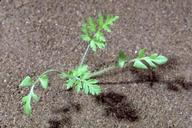
Filaree
Identification tip: Cotyledons are lobed (3-4 lobes); the largest is the center lobe. Young
leaves are arranged as opposite or alternate. Both leaves and stems are bristly and hairy. |

Common chickweed
Identification tip: Seed leaves are oval with a hairy stalk as long as the blade, have
prominent midveins, and are about four times as long as broad, tapering to a point at the tip. True leaves
are egg-shaped to rounded, pointed at the apex, opposite, and yellow-green. |

Common groundsel
Identification tip: Seed leaves are elongate and club-shaped, with a blunt, rounded tip.
The first true leaves have shallow teeth; the third and fourth leaves are more deeply lobed. Stalks of the
cotyledons and true leaves are grooved. The cotyledons and young leaves are often purplish on the lower surface. |
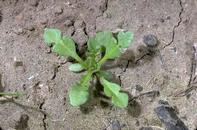
Shepherd’s-purse
Identification tip: Seed leaves are pale green with tiny granules on the surface. The first
true leaves have smooth margins, but fourth and later leaves may be indented. The true leaves are covered
with star-shaped hairs that distinguish shepherd's-purse from most other weed seedlings. |
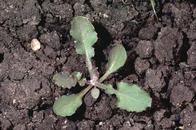
Sowthistles
Identification tip: Seedling has markedly stalked, almost spoon-shaped seed leaves, rounded
at the tip. The seed leaves and young leaves often have a grayish-white powdery coating, but later leaves
have only a few hairs. |
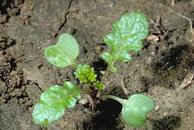
Mustards
Identification tip: All mustard seedlings have broad seed leaves with a deep notch at the
tip. The first true leaves are bright green on the upper surface and paler below. |
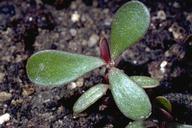
Common purslane
Identification tip: Seed leaves are oblong, somewhat club-shaped and succulent, maroon on
the lower surface, and either green or maroon on the upper surface. Young leaves are smooth and succulent,
green on the upper surface, and maroonish underneath, oblong, broadest around
the apex, with a short petiole. |
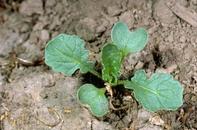
Wild radish
Identification tip: Seed leaves are broad with a deep notch at the tip. The first true leaves
are irregularly lobed and may have separate lobes at the base of the leaf blade. Seedlings resemble mustards
in the genus Brassica but are duller green and rougher textured. |
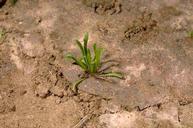
Redmaids
Identification tip: Seed leaves are long, narrow, and bright green. First true leaves are
somewhat broader, fleshy, and lacking definite stalks, distinguishing them from the seedlings of miner's
lettuce. |
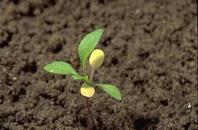
London rocket
Identification tip: The margins of the seedling’s first true leaves are always indented,
distinguishing seedlings of London rocket from those of shepherd’s purse. Seedlings have deeply lobed
leaves. |

Prickly lettuce
Identification tip: Seedlings have cotyledons that are about twice as long as they are wide. The first
true leaves have rounded margins. Leaves are alternate, clasp the stem, and may be lobed or entire with prickly
margins. |

Mallow
Identification tip: Seed leaves are distinctly heart-shaped and tinged red on relatively
long grooved stalks that are hairy in the ridges. True leaves are alternate, roundish and somewhat crinkly,
with wavy, shallow-toothed margins and a red spot at the leaf base. |
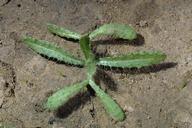
Fiddleneck
Identification tip: Seedlings have "Y" shaped cotyledons with tiny blisters and
a few fine hairs. Early leaves have coarse, sharp hairs and are 4 to 6 times as long as they are wide. |
Grasses
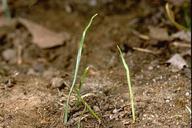
Ryegrass
Identification tip for annual ryegrass: The first blade is
long and narrow and stands erect. Leaves are rolled in the bud, the ligule is membranous; generally, auricles
are present, but may be absent on very young seedlings. Blades are about 50 times longer than they are wide
and
have a
shiny, varnished appearance. Identification tip for perennial ryegrass: Shorter than annual ryegrass
with distorted auricles. |
No photo available
Cupgrass
Identification tip: Seedlings look similar to large crabgrass and can be distinguished by
the lighter green color and absence of hairs. |
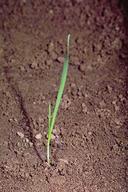
Foxtail barley
Identification tip: The collar region has membranous ligules and, unlike hare barley, has
no auricles. |
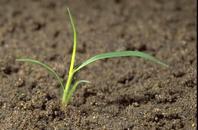
Lovegrass U
Identification tip: The seedling is very narrow, light green, and inconspicuous. The second
and third leaves are light green, short, and about 1/10 inch wide. Tufts of hair arise from the base of the
third leaf. |

Annual bluegrass
Identification tip: Annual bluegrass can easily be distinguished from other grasses by its
leaf tip, which is shaped like the bow of a boat. The leaf blade is often crinkled at the midsection. Annual
bluegrass has a membranous ligule that is rounded with a slightly pointed tip. |
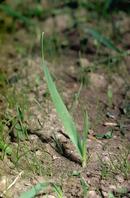
Wild oat
Identification tip: Seedlings have hairy foliage, like hare barley. However, wild oat keeps
the seed from which it is growing for a long time. |
Domestic Cereals and Perennials
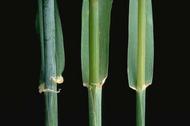
Wheat
Identification tip: Wheat can be distinguished
from most other grasses by the way the ligules clasp the stem
but barely overlap. Ligules on barley plants are longer and overlap
one another more completely. Shown left to right are collar regions of barley, wheat, and oats. |
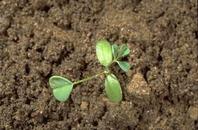
Perennial clovers: White clover
Identification tip: Cotyledons are spatulate and smooth with blades that taper into the petiole. The first
leaf is simple, truncated at the base, and round to broadly oval. Later leaves are trifoliate, smooth, alternate,
gray-green on the lower surface, and green on the upper surface. There is usually a light-green splotch near the
base of each leaflet. |
|


